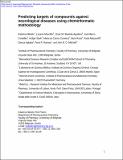Predicting targets of compounds against neurological diseases using cheminformatic methodology
Abstract
Recently developed multi-targeted ligands are novel drug candidates able to interact with monoamine oxidase A and B; acetylcholinesterase and butyrylcholinesterase; or with histamine N-methyltransferase and histamine H3-receptor (H3R). These proteins are drug targets in the treatment of depression, Alzheimer’s disease, obsessive disorders, and Parkinson’s disease. A probabilistic method, the Parzen–Rosenblatt window approach, was used to build a “predictor” model using data collected from the ChEMBL database. The model can be used to predict both the primary pharmaceutical target and off-targets of a compound based on its structure. Molecular structures were represented based on the circular fingerprint methodology. The same approach was used to build a “predictor” model from the DrugBank dataset to determine the main pharmacological groups of the compound. The study of off-target interactions is now recognised as crucial to the understanding of both drug action and toxicology. Primary pharmaceutical targets and off-targets for the novel multi-target ligands were examined by use of the developed cheminformatic method. Several multi-target ligands were selected for further study, as compounds with possible additional beneficial pharmacological activities. The cheminformatic targets identifications were in agreement with four 3D-QSAR (H3R/D1R/D2R/5-HT2aR) models and by in vitro assays for serotonin 5-HT1a and 5-HT2a receptor binding of the most promising ligand (71/MBA-VEG8).
Citation
Nikolic , K , Mavridis , L , Bautista-Aguilera , O M , Marco-Contelles , J , Stark , H , Carreiras , M D C , Rossi , I , Massarelli , P , Agbaba , D , Ramsay , R R & Mitchell , J B O 2015 , ' Predicting targets of compounds against neurological diseases using cheminformatic methodology ' , Journal of Computer-Aided Molecular Design , vol. 29 , no. 2 , pp. 183-198 . https://doi.org/10.1007/s10822-014-9816-1
Publication
Journal of Computer-Aided Molecular Design
Status
Peer reviewed
ISSN
0920-654XType
Journal article
Description
The authors acknowledge financial support from the Scottish Universities Life Sciences Alliance (SULSA). OMBA and JMC thank MINECO (Spain) for a fellowship, and support (SAF2012-33304), respectively. KN and DA acknowledge project supported by the Ministry of Education and Science of the Republic of Serbia, Contract No. 172033. Further supports by Else Kroner-Fresenius-Stiftung, Translational Research Innovation—Pharma (TRIP), Fraunhofer-Projektgruppe fur Translationale Medizin und Pharmakologie (TMP) (to HS) and the European COST Actions BM1007, CM1103 (including STSM 10295 to KN), and CM1207 are also gratefully acknowledged.Collections
Items in the St Andrews Research Repository are protected by copyright, with all rights reserved, unless otherwise indicated.

